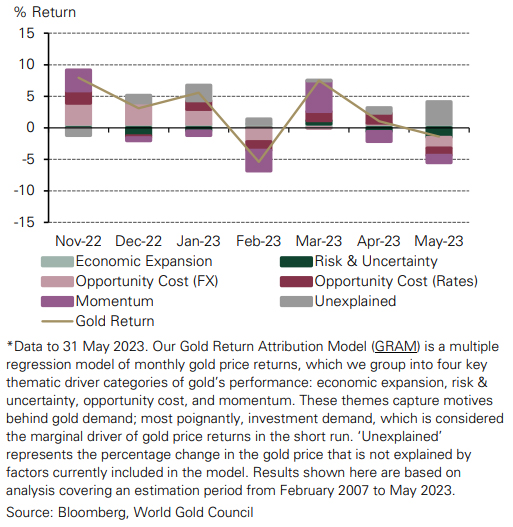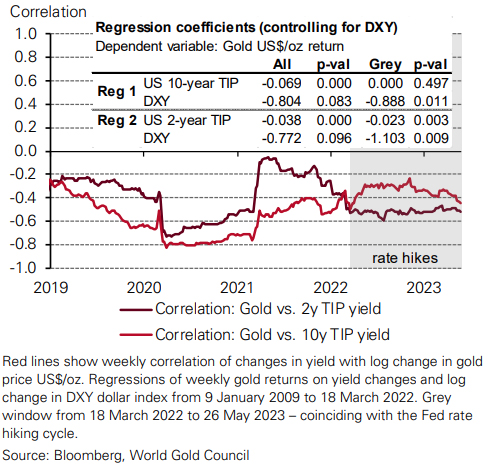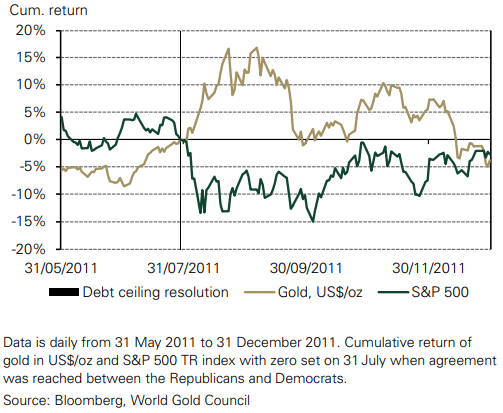
The following is a re-post from the World Gold Council. The original is here.
May in review
- Gold fell 0.9% in May, but currency moves were a prominent factor and outside of the US and Canada, gold saw gains
- Global gold ETFs added to holdings for the third month in a row, but these gains were offset by a fall in Managed Money net long futures positions
Looking forward
- Another possible Fed rate hike has pushed bond yields higher and could be a short-term drag for gold – however, re-establishing a link with an old friend, the 10-year TIP yield, could add some support for gold
- Debt-ceiling uncertainty has passed, removing some fear from markets, but the implications of what follows could be gold friendly
A small drop and an invisible hand
Gold fell 0.9% in May to US$1,964, leaving the y-t-d return at 8.3%. But the fall was marginal and in part attributable to strength in North American currencies (USD, CAD). In other currencies gold made gains (Table 1).
Our gold model GRAM (Chart 1) points to a drag from all identified drivers of gold during May, led by a rise in opportunity cost, a fall in risk and a drag from momentum factors. However, gold was almost 3.5% better off than these drivers suggested it should have been.
The unexplained portion - or residual of GRAM - is statistically stable over time, but has been more positive than negative over the past 12 months. We have addressed this phenomenon previously and posit three explanations: an omitted variable, a temporary shift in gold’s sensitivity to one or more of these factors, or noise. Candidates for omitted variables are central bank buying or a geopolitical risk premium. Alternatively, if we estimate the model over the most recent three years rather than the full fifteen, the implied impact of interest rates falls substantially in favour of a rise in the impact of FX. As we discuss in our forward-looking section, it’s possible that a portion of our model’s unexplained factor is a shift in focus by investors from 10-year Treasuries to 2-year Treasuries as well as a greater focus on US dollar moves.
In May, global gold ETFs added 19t to holdings for the third month in a row, but were offset by a fall of 79t in Managed Money net long futures positions on COMEX.
Chart 1: Another large positive unexplained factor saved gold from a larger drop in May*

Towards the end of the quarter, gold was unsuccessful in sustaining momentum above the US$2,000/oz level, which it hit on three separate occasions in March (Chart 1). As concerns over the banking crisis eased, gold fell back somewhat as tactical demand for safe havens abated and gold fell back somewhat.
On a quarterly average basis, gold jumped to US$1,890/oz, just 1% off the record high seen in Q3 2020 (US$1,911/oz). This was against a backdrop of increasing confidence that the cycle of monetary tightening may soon end.
Using our Gold Returns Attribution Model (GRAM), gold found support from lower yields and, to a lesser extent, a weaker US dollar (Chart 2). It was a tumultuous quarter for yields, with a spike in interest rate volatility as rate expectations were repriced in response to the SVB event.
Yields on US 10-year Treasuries fell by 40 basis points, boosting gold’s performance.
We believe that focus should also be placed on the unexplained component of the model which was positive in each of the first three months.
This could, in part, represent the continued strength in central bank demand for gold. Using the rule of thumb from our Qaurum model that it takes c.30t of gold demand to move the price 1%, a 4.8% cumulative residual suggests a figure of about 140t gold, which coincidentally is close to that already reported by central banks so far.
Table 1: Gold fell marginally in North American currencies, but gained elsewhere
Gold price and return in different periods across key currencies*
| USD (oz) | EUR (oz) | JPY (g) | INR (10g) | RMB (g) | AUD (oz) | |
| 31 May 2023 price | 1,964 | 1,838 | 8,800 | 52,249 | 449 | 3,021 |
| May return | -0.9% | 2.1% | 1.3% | 0.2% | 1.8% | 0.8% |
| Y-t-d Return | 8.3% | 8.5% | 15.1% | 8.3% | 11.6% | 13.5% |
*Data to 31 May 2023. Based on the LBMA Gold Price PM in local currencies
Source: Bloomberg, ICE Benchmark Administration, World Gold Council
Considerations for June
- Recent strong data has led to a slightly higher than expected Fed terminal rate and fewer cuts in 2023 – a near-term gold headwind; but more visibility on where rates might peak could re-establish gold’s link to longer maturity yields – a medium-term gold tailwind
- A debt ceiling deal might be seen as a negative for gold, having averted a potential default. But in 2011 it proved the opposite, at least in the near term. Given such high stakes, partisan wrangling until 2024 elections should offer more support for gold.
One more hike?
The FOMC meeting scheduled for June is expected to be the first ‘hold’ since February 2022. But a slew of ‘hot’ data has raised the probability of a further hike.1 Notwithstanding a weak ISM new orders figure, rate futures pricing now points to a 30% probability of another 25bp hike this month and a 50% probability that one will arrive in July.2
This has prompted a rise in yields, even in the parts of the curve unaffected by the debt-ceiling stand-off. The 2-year TIP yield is nudging 2.5%3 – a level that might make some gold investors a little nervous. To boot and along with a more influential US dollar, it has done a better job of explaining recent gold returns than the 10-year TIP yield (Chart 2). Historically, the 10-year explains twice as much of the returns of gold as the 2-year. But it makes sense that the 2-year is more dominant now alongside the dollar as both are more closely associated with near-term monetary policy and inflation dynamics, which have been central to market narratives for more than a year.4
To wit, an end to hikes might stop gold dancing to the tune of the 2-year. And it may re-establish a stronger link to the 10-year yield, which currently sits just below 1.5%, almost 100bps lower than the 2-year yield and at a level not historically challenging for gold.
Chart 2: The US dollar and 2-year TIP yield have been stronger drivers over the past 15 months

Red lines show weekly correlation of changes in yield with log change in gold price US$/oz. Regressions of weekly gold returns on yield changes and log change in DXY dollar index from 9 January 2009 to 18 March 2022. Grey window from 18 March 2022 to 26 May 2023 – coinciding with the Fed rate hiking cycle.
Deal struck but future uncertain
The deal struck between Democrats and Republicans in the debt-ceiling saga may calm near-term skittish bond prices. But a cynical analyst might say that any bipartisan agreement will not be for the good of the economy as each side seeks to make the other look bad ahead of 2024 elections.
Other potential repercussions are lower fiscal spending and higher T-bill issuance.5 The former could put fewer dollars in the hands of households and thus curtail some savings-related gold buying. On the other hand, an acceleration of the economic slowdown could promote growing interest in institutional and high net worth (HNW) investment in gold. Increased issuance could raise funding costs as investors would need to be incentivised to leave the cosy confines of money market funds, for example. Higher funding costs are a double-edged sword for gold. Yields go up but at what economic cost, given already tight conditions? Net, net: probably gold positive.
And looking back at the debt ceiling deal struck in 2011, the immediate reaction reverberated through markets quite violently, partly on a downgrade of the US’s credit rating and partly from the economic weakness that was expected to materialise (Chart 3). The current deal has been touted as a positive in that it avoids a cataclysmic default and has so far elicited a positive reaction from equities and other risk assets. But these remain, in our view, in a fragile state. A 2023 recession continues to be a strong possibility and politics are unlikely to get friendlier as we approach election season in the US.
Chart 3: In 2011 gold responded to a sharp equity sell off after the debt ceiling deal was struck

In summary
Gold prices remain rangebound, having failed to establish a foothold above the psychologically important US$2,000 level. It appears that over the past year, gold has been more influenced by the US dollar than on average, as well as taking its cues from the 2-year US TIP yield rather than the more commonly associated 10-year. This makes sense in the current environment. But as inflation recedes and monetary policy perhaps becomes less certain, gold could re-establish a link to the 10-year TIP yield which is currently almost 100bps lower than the 2-year.
The debt-ceiling agreement has not triggered an equity sell-off as it did in 2011. But stakes remain high and lower fiscal spending and higher funding costs could accelerate the onset of a recession – a continuing and likely risk in 2023 according to economists. Recessions have been good for gold in the past.
Regional insights
China: A m-o-m decline in local gold withdrawals from the Shanghai Gold Exchange and a falling local price premium point to weaker wholesale gold demand. We believe seasonality, a higher RMB gold price and slowing economic momentum weighed on demand in May. Our recent trade visit also indicates slower sales after the boost during the five-day Labour Day Holiday between 29 April and 3 May.
US: Cooling inflation and softer gold prices may have contributed to a sharp m-o-m drop in Eagle and Buffalo coin sales by the US Mint in May. In total, it sold 124k ounces of gold bullion coins, sharply down from April’s lofty levels. But sales were still healthy in the context of longer-term average levels, and likely drew support from the debt ceiling debate throughout the month.
Europe: Germany experienced a technical recession. GDP shrank 0.3% in Q1 following a 0.5% contraction in Q4 last year. Meanwhile, European Central Bank (ECB) policymakers reiterated that interest rates would need to rise further and stay high to curb inflation in the medium term. In the UK, core inflation rose to a 21-year high of 6.8% in April from 6.2% in March. The result fuelled market expectations for a 13th consecutive interest rate hike in June.
Central banks: Global official gold reserves fell by 71t in April, the first net decrease since last March (-1t). This was mainly due to Türkiye’s 81t sale into its domestic market to satisfy its surging local gold demand. Other notable sellers include Kazakhstan (-13t), Uzbekistan (-2t) and Kyrgyz Republic (-0.6t). Four central banks reported gold purchases, with the largest from Poland (+15t). This was followed by China (+8t), Czech (+2t) and Mongolia (+1t).
ETFs: Global physically-backed gold ETFs (Table 2) saw the third months of inflows in May (+US$1.7bn), bringing their y-t-d flows to positive territory at US$1bn. Collective holdings of global gold ETFs rose 19t to 3,478t. But their total assets under management (AUM) fell slightly by 0.4% to US$220bn due to a lower gold price in May.
Table 2: Global gold ETFs saw another inflow in May
Gold ETF holdings and flows by region*
| Total AUM (bn) |
Fund Flows (US$mn) |
Holdings (tonnes) |
Demand (tonnes) |
|
| North America | 112.0 | 1,399.2 | 1,773.7 | 21.2 |
| Europe | 96.2 | 228.4 | 1,523.0 | -2.1 |
| Asia | 7.8 | 8.6 | 118.2 | 0.1 |
| Other | 4.0 | 24.5 | 63.4 | 0.0 |
| Total | 220.0 | 1,660.8 | 3,478.3 | 19.3 |
*Data to 31 May 2023. On Goldhub, see: Gold-backed ETF flows.
Source: Bloomberg, ICE Benchmark Administration, World Gold Council
Notes:
-
Q1 2023 US GDP, core PCE, initial and continuing claims, durable goods and consumer spending, among others, see here.
-
As of 1 June 2023.
-
Please note that these are only two of many short-term drivers for gold. See GRAM for a more comprehensive list and Qaurum for long-term drivers
![]() Our free weekly precious metals email brings you weekly news of interest to precious metals investors, plus a comprehensive list of gold and silver buy and sell prices.
Our free weekly precious metals email brings you weekly news of interest to precious metals investors, plus a comprehensive list of gold and silver buy and sell prices.
To subscribe to our weekly precious metals email, enter your email address here. It's free.
Comparative pricing
You can find our independent comparative pricing for bullion, coins, and used 'scrap' in both US dollars and New Zealand dollars which are updated on a daily basis here »

We welcome your comments below. If you are not already registered, please register to comment.
Remember we welcome robust, respectful and insightful debate. We don't welcome abusive or defamatory comments and will de-register those repeatedly making such comments. Our current comment policy is here.